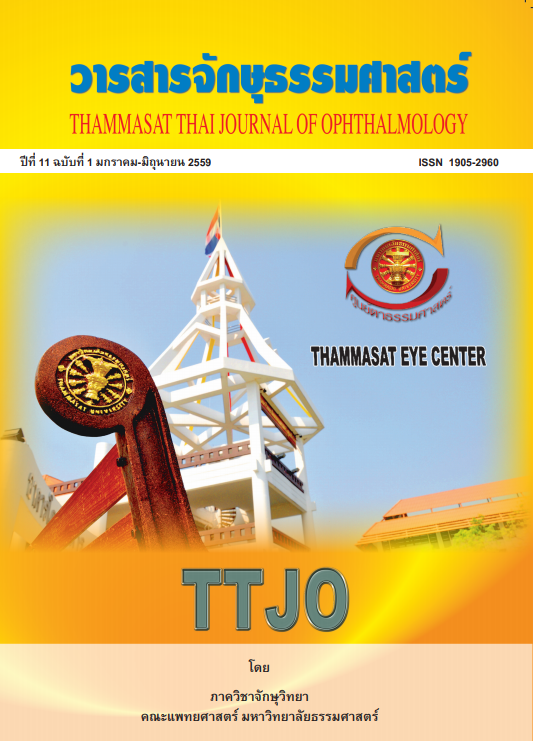เส้นประสาทสมองที่สามเป็นอัมพาตเนื่องจากภาวะหลอดเลือดคาโรติดโป่งพอง
Main Article Content
Abstract
บทคัดยอ ภาวะอัมพาตประสาทสมองเสนที่สามรวมกับมีการตอบสนองของรูมานตาผิดปกติมักมีสาเหตุที่พบได บอยจากการกดทับเนื่องจากลักษณะการเรียงตัวของเสนใยประสาทที่ทําหนาที่ตอบสนองของรูมานตา ภาวะ หลอดเลือดแดงโปงพองเปนสาเหตุกดทับเสนประสาทสมองที่สามารถทําใหเกิดอันตรายถึงชีวิตได การตรวจ รางกายเพื่อแยกวาการตอบสนองของรูมานตาผิดปกติหรือไมจึงมีความสําคัญทางคลินิก รายงานผูปวยหญิงไทย อายุ 51 ปมาดวยอาการหนังตาตกเปนมากขึ้น ปวดและเห็นภาพซอน 3 สัปดาห ตรวจตาพบหนังตาขวาตก มากบังการมองเห็น ไมสามารถกลอกตาขึ้นบน ลงลางหรือกลอกเขาในไดและรูมานตาขยายขนาดผิดปกติ ไม ตอบสนองตอแสงในตาขางขวา การตรวจรางกายทางระบบประสาทไมพบอัมพาตของเสนประสาทสมองเสน อื่น ผลตรวจเอกซเรยคลื่นแมเหล็กไฟฟาสมองและเบาตาไมพบความผิดปกติ ผลตรวจเอกซเรยคอมพิวเตอร หลอดเลือดสมองพบหลอดเลือดคาโรติดดานขวาโปงพอง ผูปวยไดรับการผาตัดวิธีใสคลิปหนีบที่บริเวณฐาน ของหลอดเลือดโปงพองเปนผลสําเร็จและไดรับการตรวจติดตามเพื่อดูการกลับมาทํางานของเสนประสาทหลัง การรักษา
Pupil involving third nerve palsy secondary to ICA aneurysm
Abstract
Pupil involving third nerve palsies are commonly related to compressive lesions due to the arrangement of the pupilo-motor fibers of the nerve. Aneurysmal compression can cause life-threatening complications. Distinguishing between pupil involving and pupil sparing third nerve palsies are of great clinical importance. We present a 51 -year-old healthy female complaining of worsening ptosis and painful diplopia for about 3 weeks. Eye examinations revealed a complete ptosis, limitation of supraduction, infraduction, adduction, and complete mydriasis in the right eye. Neurological examinations revealed no involvement of other cranial nerves. MRI brain and orbit studies were unremarkable. CTA brain revealed a saccular aneurysm from the right internal carotid artery. The aneurysm was successfully treated by a clipping procedure. The patient was followed-up for the recovery of third cranial nerve function.
Article Details
References
Soni SR. Aneurysms of the posterior communicating artery and oculomotor paresis. J Neurol Neurosurg Psychiatry 1974;37(4):475-84.
Trobe J. Searching for brain aneurysm in third cranial nerve palsy. J Neuro-Ophthalmol 2009;29(3):171-3.
Kerr FWL, Hollowell OW. Location of pupillomotor and accommodation fibers in the oculomotor nerve: experimental observations on paralytic mydriasis. J Neurol Neurosurg Psych. 1964;27:473–81.
Trobe JD. Third nerve palsy and the pupil. Footnotes to the rule. Arch Ophthalmol 1988;106:601-2.
Trobe JD. Managing oculomotor nerve palsy. Arch Ophthalmol 1998;116:798-802.
Chaudhary N, Imaging of intracranial aneurysms causing isolated third nerve palsy. J Neuro-Ophthalmol 2009;29(8):238-44.
Lee AG, Hayman LA, Brazis PW. The evaluation of isolated third nerve palsy revisited: an update on the evolving role of magnetic resonance, computed tomography, and catheter angiography. Surv Ophthalmol 2002;47:137-57.
Elmalem VI, Hudgins PA, Bruce BB, Newman NJ, Biousse V. Underdiagnosis of posterior communicating artery aneurysm in non-invasive brain vascular studies. J Neuroophthalmol.2011;31(2):103-109.
White PM, Wardlaw JM, Easton V. “Can noninvasive imaging accurately depict intracranial aneurysms” A systematic review” Radiology. 2000;217(2):361-370.
Kapsalaki EZ, Rountas CD, Fountas KN. The role of 3 Tesla MRA in the detection of intracranial aneurysms. International Journal of Vascular Medicine. 2012;2012:792834. Epub 2012 Jan 16.
O'Connor PS, Tredici TJ, Green RP. Pupillary-sparing third nerve palsy due to aneurysm: a survey of 2419 neurological surgeons. J Neurosurg. 1983;58:792–793.
Lanzino G, Andreoli A. Orbital pain and unruptured posterior communicating artery aneurysms: the role of sensory fibers of the third cranial nerve. Acta Neurochir. 1993;120:7–11.
McKinna A. Eye signs in 611 cases of posterior fossa aneurysms: their diagnostic and prognostic value. Can J Ophthalmol 1983;18:3-6.


